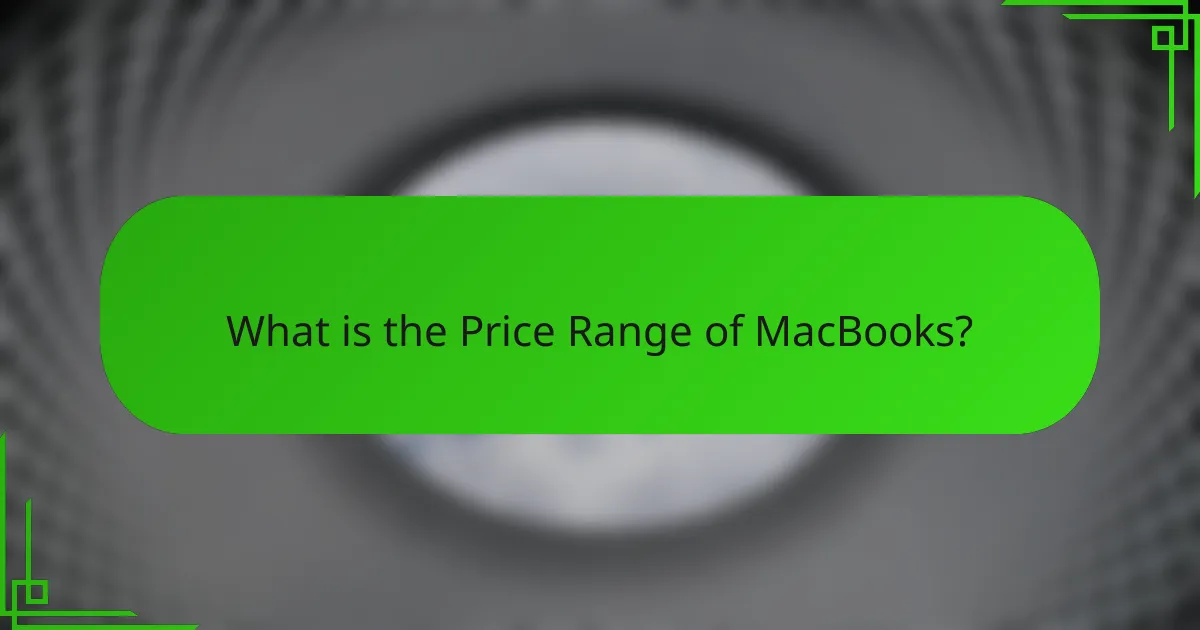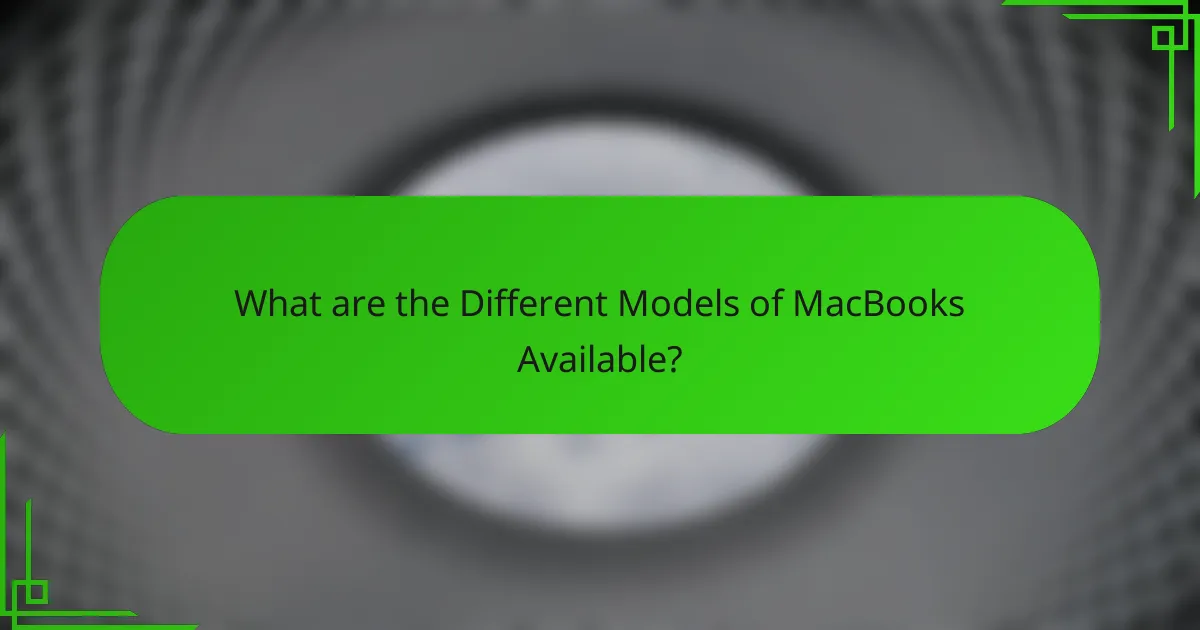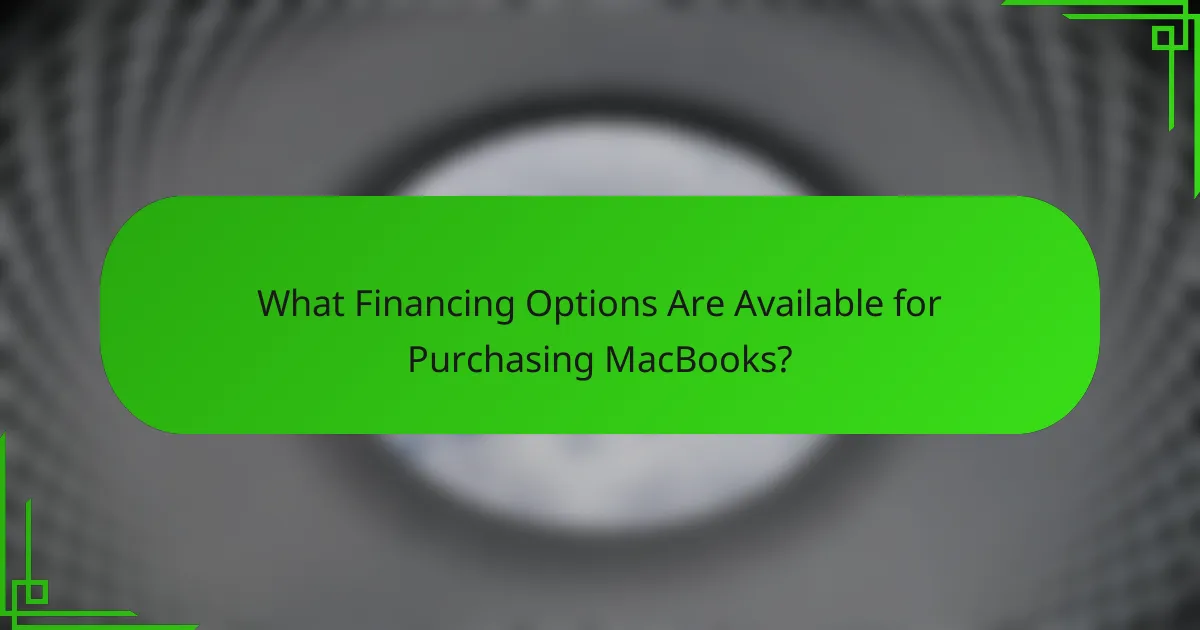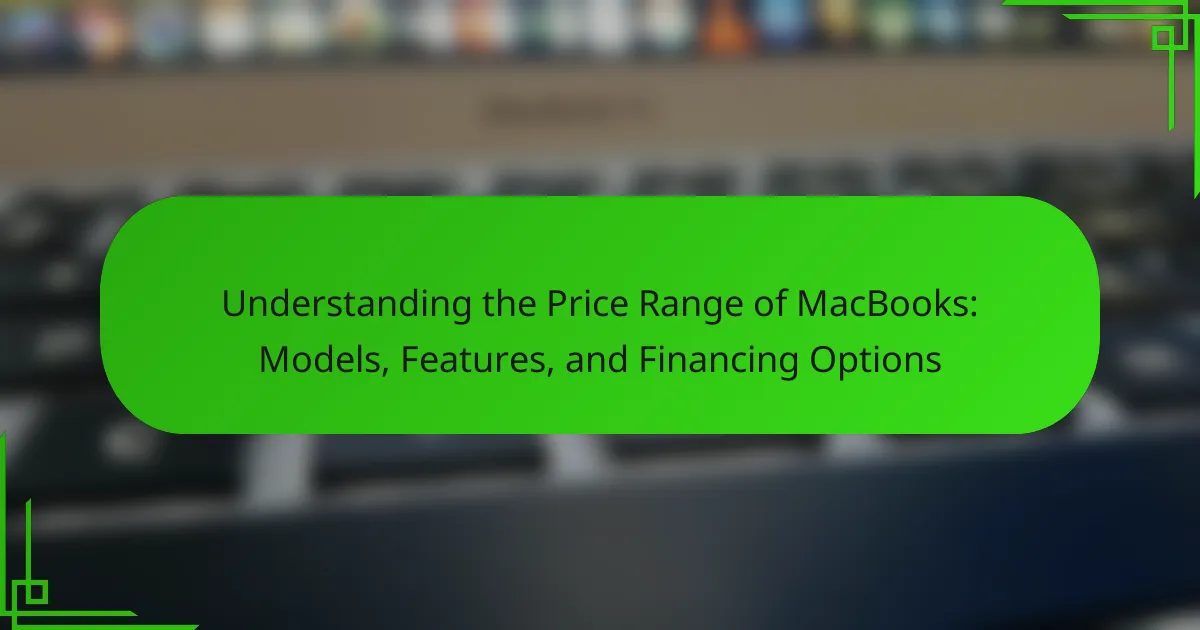The article provides a detailed overview of MacBooks, focusing on their price range, models, features, and financing options. MacBooks typically start at around $999 for the entry-level MacBook Air and can exceed $2,499 for higher-end MacBook Pro models with advanced configurations. The MacBook Air is designed for portability and efficiency, while the MacBook Pro offers enhanced processing power suitable for professional use. Additionally, various financing options, including Apple’s financing plan and third-party lenders, are available to help customers manage the cost of their purchases. This comprehensive summary equips readers with essential information to understand the MacBook lineup and associated financial considerations.

What is the Price Range of MacBooks?
The price range of MacBooks typically starts from around $999 and can go up to $2,499 or more. The entry-level MacBook Air is priced at approximately $999. Higher-end models like the MacBook Pro can reach prices of $2,499 for advanced configurations. Prices vary based on specifications such as storage, processor, and display size. For example, a MacBook Pro with enhanced features can significantly increase the total cost. This pricing structure reflects Apple’s positioning in the premium laptop market.
How do different MacBook models impact their pricing?
Different MacBook models significantly impact their pricing based on specifications and features. The MacBook Air is generally the most affordable option. It features lower-end processors and less RAM compared to the MacBook Pro. The MacBook Pro, with its higher performance specifications, commands a premium price. Variants of the MacBook Pro, such as the 14-inch and 16-inch models, have increased costs due to enhanced features like better displays and more powerful processors. Additionally, storage capacity influences pricing. Higher storage options lead to increased prices across all models. Apple’s consistent updates and new releases also affect pricing trends, often leading to price reductions on older models. Thus, the model chosen directly correlates with the price paid.
What are the key features that influence MacBook prices?
Key features that influence MacBook prices include processor type, storage capacity, RAM size, and display quality. The processor type affects performance and speed. Higher-end processors, like the M1 or M2 chips, increase the price. Storage capacity impacts how much data can be stored. Models with larger SSDs are typically more expensive. RAM size also plays a role in multitasking capabilities. More RAM generally leads to higher costs. Display quality, including Retina and resolution, influences visual experience and pricing. Additional features such as battery life and build materials can further affect the overall price.
How do specifications vary across different models?
Specifications vary across different MacBook models primarily in processing power, display quality, and storage options. For instance, the MacBook Air typically features lower processing capabilities compared to the MacBook Pro. The MacBook Pro offers advanced processors and higher RAM configurations, catering to professionals needing more power. Display sizes also differ; the MacBook Air has a 13-inch display, while the Pro is available in 14-inch and 16-inch sizes. Additionally, the Pro models support higher resolutions and better color accuracy. Storage options range from 256GB in the Air to 8TB in the top-tier Pro models. These variations reflect the intended use cases of each model, from casual use to professional applications.
Why is understanding MacBook pricing important for consumers?
Understanding MacBook pricing is crucial for consumers to make informed purchasing decisions. It allows consumers to compare models and features effectively. Knowledge of pricing helps identify budget-friendly options. Consumers can assess the value of features against costs. Understanding pricing trends can reveal when to buy for the best deals. It also aids in recognizing potential financing options available. For instance, Apple often offers trade-in programs that can reduce costs significantly. In 2022, the average price of a MacBook was around $1,000, emphasizing the need for careful consideration.
What factors should buyers consider when evaluating MacBook prices?
Buyers should consider several factors when evaluating MacBook prices. Key factors include the model type, which significantly influences the price. For instance, MacBook Air models are typically less expensive than MacBook Pro models.
Another factor is the specifications, such as processor speed, RAM, and storage capacity. Higher specifications generally lead to higher prices. The age of the model is also important; newer models often come with a premium price tag.
Buyers should also evaluate warranty and support options, as these can add to the overall cost. Seasonal sales and promotions can affect pricing as well. Lastly, considering financing options can impact the affordability of the purchase.
In summary, model type, specifications, model age, warranty, seasonal pricing, and financing options are all critical factors for buyers to consider when evaluating MacBook prices.
How does the price of a MacBook reflect its value?
The price of a MacBook reflects its value through the quality of materials, performance, and brand reputation. MacBooks are constructed with premium materials such as aluminum and Retina displays. This construction contributes to their durability and aesthetic appeal. Performance is driven by powerful hardware, including M1 or M2 chips, which enhance speed and efficiency. Additionally, MacBooks offer a seamless ecosystem with other Apple products, adding to their overall value. Brand reputation plays a crucial role, as Apple is known for reliability and customer service. According to a 2021 report by Statista, Apple consistently ranks high in customer satisfaction, reinforcing the perceived value of its products.

What are the Different Models of MacBooks Available?
The different models of MacBooks available are the MacBook Air and the MacBook Pro. The MacBook Air is known for its lightweight design and portability. It features the M1 or M2 chip, offering efficient performance for everyday tasks. The MacBook Pro comes in 13-inch, 14-inch, and 16-inch versions. It provides higher processing power with M1 Pro, M1 Max, or M2 chips. The Pro models are designed for professionals needing advanced capabilities. Each model varies in specifications, such as RAM, storage options, and display quality. These distinctions help users choose based on their requirements and budget.
How do the MacBook Air and MacBook Pro differ in price?
The MacBook Air is generally less expensive than the MacBook Pro. The starting price for the MacBook Air is around $999. In contrast, the MacBook Pro starts at approximately $1,299. The price difference can be attributed to the Pro’s advanced features. These features include higher processing power and enhanced graphics capabilities. The MacBook Pro also offers more storage options. Additionally, the MacBook Pro is available in larger screen sizes. This pricing structure reflects the target audience and intended use for each model.
What are the unique features of the MacBook Air that affect its pricing?
The unique features of the MacBook Air that affect its pricing include its lightweight design, Retina display, and Apple M1 chip. The lightweight design enhances portability, making it appealing for users on the go. The Retina display provides high-resolution visuals, which is a significant selling point. The Apple M1 chip delivers superior performance and energy efficiency compared to previous models. Additionally, the build quality and materials used contribute to its premium pricing. The integration of macOS and exclusive features like Touch ID also add value. These attributes collectively justify the MacBook Air’s price point in the competitive laptop market.
What advantages does the MacBook Pro offer that justify its price?
The MacBook Pro offers several advantages that justify its price. It features high-performance processors, such as the M1 and M2 chips. These chips provide significant speed and efficiency improvements. The Retina display offers exceptional color accuracy and brightness. This enhances visual experiences for creative professionals. The build quality is premium, using durable materials. This contributes to longevity and reliability. Battery life is impressive, lasting up to 20 hours on a single charge. The MacBook Pro also has a robust ecosystem of software optimized for its hardware. This ensures seamless performance for tasks ranging from video editing to software development. Overall, these attributes combine to provide value that aligns with its price.
What are the latest MacBook models and their price ranges?
The latest MacBook models include the MacBook Air (M2), MacBook Pro 13-inch (M2), MacBook Pro 14-inch (M2 Pro), and MacBook Pro 16-inch (M2 Pro/M2 Max). The MacBook Air (M2) starts at $999. The MacBook Pro 13-inch (M2) begins at $1,299. The MacBook Pro 14-inch (M2 Pro) has a starting price of $1,999. The MacBook Pro 16-inch (M2 Pro) starts at $2,499, while the M2 Max version starts at $3,099. These prices reflect Apple’s official pricing as of October 2023.
How do the features of the latest models compare to previous versions?
The features of the latest MacBook models significantly enhance performance compared to previous versions. The latest models incorporate Apple’s M1 and M2 chips, which provide improved processing power and energy efficiency. Previous versions relied on Intel processors, which did not match the speed and battery life of the new chips. The latest models also offer Liquid Retina XDR displays, delivering higher brightness and color accuracy than older displays. Additionally, the latest MacBooks support more RAM and storage options, enhancing multitasking capabilities. These advancements lead to faster data processing and better graphics performance. Overall, the latest models present substantial upgrades in technology and usability compared to their predecessors.
What should consumers know about model-specific pricing trends?
Model-specific pricing trends indicate that prices for MacBook models vary significantly based on features and specifications. Higher-end models typically command premium prices due to advanced hardware and capabilities. For example, the MacBook Pro with M1 chip often costs more than the MacBook Air with similar specifications. Additionally, new releases generally see higher initial prices, which may decrease over time as newer models are introduced. This trend reflects consumer demand and technological advancements. According to a report by IDC, the average selling price of MacBooks increased by 10% in 2022, highlighting the impact of model specifications on pricing. Understanding these trends helps consumers make informed purchasing decisions based on their budget and needs.

What Financing Options Are Available for Purchasing MacBooks?
Financing options for purchasing MacBooks include Apple’s financing plan, third-party lenders, and credit cards. Apple offers a monthly payment plan through the Apple Card, allowing customers to finance their purchase with 0% interest for a limited time. Third-party lenders, like Affirm or PayPal Credit, provide similar financing options with varying interest rates and terms. Many credit cards also offer promotional financing options, such as deferred interest for a specific period. These options enable customers to spread the cost of a MacBook over several months, making it more affordable.
How can consumers finance their MacBook purchases?
Consumers can finance their MacBook purchases through several options. They can use Apple’s financing program, which offers monthly payment plans. This program allows consumers to spread the cost over 12 or 24 months. Retailers often provide financing options as well. These may include credit card offers with promotional interest rates. Third-party financing services are also available, providing loans specifically for electronics purchases. Consumers should compare interest rates and terms before choosing a financing option. This ensures they select the most cost-effective solution for their budget.
What are the most common financing plans offered by retailers?
Retailers commonly offer several financing plans. These include installment plans, which allow customers to pay for products over a set period. Another common option is deferred interest financing, where no interest is charged if the balance is paid in full by a specific date. Some retailers provide lease-to-own plans, enabling customers to lease items with the option to purchase later. Additionally, retailers often partner with third-party financing companies to offer credit lines. These plans generally have varying terms and conditions. Specific details about interest rates and repayment periods can differ significantly between retailers.
What are the benefits and drawbacks of financing a MacBook?
Financing a MacBook offers advantages and disadvantages. One benefit is that it allows users to spread payments over time. This can make purchasing a high-cost item more manageable. Another benefit is the ability to acquire the latest technology without paying the full price upfront. Financing options often come with promotional interest rates, which can save money if paid off quickly.
However, drawbacks exist as well. Financing a MacBook can lead to long-term debt if payments are not managed properly. Interest rates may increase significantly after promotional periods, raising the overall cost. Additionally, missing payments can negatively impact credit scores. Overall, careful consideration of both benefits and drawbacks is essential before financing a MacBook.
What should buyers consider when choosing a financing option?
Buyers should consider the total cost of financing, including interest rates and fees. Different financing options offer varying interest rates that can significantly affect the overall price. Buyers should also evaluate the loan term, as longer terms may result in lower monthly payments but higher total interest paid. Additionally, credit score impacts the available financing options and rates. Buyers should assess their budget to ensure they can meet monthly payments comfortably. They should also consider any promotional offers, such as 0% interest for a limited time, which can provide savings. Understanding the terms and conditions of each financing option is crucial to avoid unexpected costs. Lastly, comparing multiple lenders can help buyers find the best deal tailored to their financial situation.
How does interest rate impact the overall cost of financing a MacBook?
Interest rates directly affect the overall cost of financing a MacBook. Higher interest rates increase the total amount paid over time. For example, a MacBook costing $1,000 financed at a 10% interest rate over 12 months results in approximately $1,100 paid in total. Conversely, a lower interest rate of 5% would lead to a total repayment of about $1,050. This difference illustrates how interest rates can significantly impact the total cost of ownership. Additionally, longer financing terms can amplify the effect of interest rates, leading to even higher overall costs.
What are the terms and conditions typically associated with MacBook financing?
MacBook financing typically includes terms such as interest rates, payment duration, and eligibility requirements. Interest rates can vary based on credit scores and financing options. Payment durations often range from 6 to 36 months. Monthly payments are calculated based on the total financed amount. Some financing plans may require a down payment. Eligibility often depends on creditworthiness and income verification. Additional fees may apply, including late payment fees. These terms ensure that buyers understand their financial commitments when financing a MacBook.
What tips can help consumers make informed decisions about MacBook purchases?
Consumers can make informed decisions about MacBook purchases by researching models and specifications. Understanding the differences between MacBook Air and MacBook Pro is essential. The MacBook Air is lightweight and ideal for everyday tasks. In contrast, the MacBook Pro offers more power for demanding applications.
Consider the storage and memory options available. MacBooks typically come with various configurations, such as 256GB to 2TB of storage and 8GB to 64GB of RAM. Evaluating personal needs against these options helps in selecting the right model.
Check for educational discounts if applicable. Apple often provides reduced prices for students and educators. Additionally, explore financing options available through Apple or authorized retailers.
Read reviews and comparisons from reputable tech websites. Websites like CNET and TechRadar offer insights into performance and user experiences. Finally, visit an Apple Store or authorized retailer to test different models. Hands-on experience can clarify preferences regarding size, weight, and keyboard feel.
The primary entity of this article is MacBooks, focusing on their price range, models, features, and financing options. The article outlines the pricing structure of MacBooks, starting from approximately $999 for the MacBook Air to over $2,499 for high-end MacBook Pro configurations. It discusses how different models and specifications, such as processor type, storage capacity, and display quality, impact pricing. Furthermore, the article highlights the importance of understanding these factors for consumers making purchasing decisions and explores various financing options available for buying MacBooks, along with key considerations for buyers.



